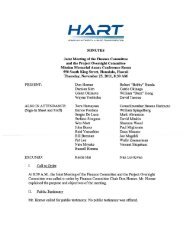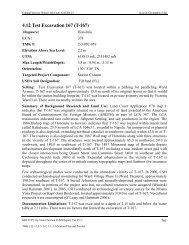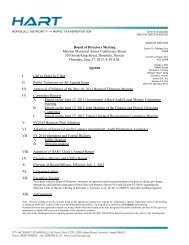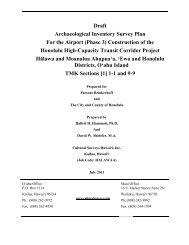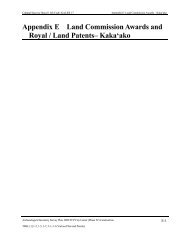AISP Kamehameha Highway Guideway - Honolulu Rail Transit Project
AISP Kamehameha Highway Guideway - Honolulu Rail Transit Project
AISP Kamehameha Highway Guideway - Honolulu Rail Transit Project
You also want an ePaper? Increase the reach of your titles
YUMPU automatically turns print PDFs into web optimized ePapers that Google loves.
Cultural Surveys Hawai‘i Job Code: MANANA 1<br />
Background Research<br />
Pa‘la‘akai in Waialua to be consecrated. Soon after becoming king, Mā‘ilikūkahi was taken by<br />
the chiefs to live at Waikīkī. The story tells us that he was probably one of the first chiefs to live<br />
there. Up until this time the chiefs had always lived at Waialua and ‘Ewa. Under his reign, the<br />
land divisions were reorganized and redefined.<br />
In reference to the productivity of the land and the population during Mā‘ilikūkahi’s reign,<br />
Kamakau writes:<br />
In the time of Mā‘ili-kūkahi, the land was full of people. From the brow, lae, of<br />
Kulihemo to the brow of Maunauna in ‘Ewa, from the brow of Maunauna to the<br />
brow of Pu‘ukea [Pu‘u Ku‘ua] the land was full of chiefs and people. From<br />
Kānewai to Halemano in Wai‘alua, from Halemano to Paupali, from Paupali to<br />
Hālawa in ‘Ewa the land was filled with chiefs and people. [Kamakau 1991:55]<br />
The picture presented here is that the whole moku (district) of ‘Ewa was one of prosperity and<br />
productivity and the land was heavily populated. ‘Ewa continued to be a political center until the<br />
18 th century when Kahahana, a Maui chief, was chosen by the O‘ahu chiefs to rule over the<br />
whole island. Kahahana was killed by Kahekili of Maui. Kahahana’s father, ‘Elani, along with<br />
other O‘ahu chiefs, plotted to kill Kahekili and his chiefs who were residing at Kailua, O‘ahu, as<br />
well as his chiefs residing at ‘Ewa and Waialua. The plot was discovered by Kahekili and a<br />
messenger was sent to warn Hū‘eu at Waialua. For some reason, the messenger never reached<br />
Hū‘eu and he and his retinue were killed. This slaughter became known as the Waipi‘o Kīmopō<br />
or the Waipi‘o assassination because it originated there. Kahekili avenged the death of Hū‘eu by<br />
pillaging and destroying the districts of Kona and ‘Ewa. It is said that the streams of Makaho and<br />
Niuhelewai in Kona, as well as Hō‘ae‘ae in ‘Ewa were choked with the bodies of the slain. It<br />
was during this time that the O‘ahu chiefly lines were nearly exterminated. It is said that one of<br />
the Maui chiefs, Kalaikoa, used the bones of the slain to build a wall around his house at<br />
Lapakea in Moanalua. The house was known as Kauwalua and could be seen as one passed by<br />
the “old upper road to ‘Ewa” (Fornander 1996:290).<br />
Even though Waikīkī was a favorite playground for the chiefs of Kona, as with ‘Ewa chiefs,<br />
there were no deep harbors where large ships could enter port. With the introduction of trade and<br />
foreign goods, along with <strong>Kamehameha</strong>’s unification of the islands, attention shifted to Kou (old<br />
name for <strong>Honolulu</strong>, used until about 1800) (Pukui et al. 1974:117), which had a deep enough<br />
harbor for ships to pull in and anchor. Kou became the center of activity as royalty moved away<br />
from the outer districts toward the center of commerce. The general populace also moved away<br />
from the rural areas, as they too became dependent on a cash economy. Archibald Campbell<br />
writes about O‘ahu in 1809:<br />
Although only of secondary size, it [O‘ahu] has become the most important island<br />
in the group, both on account of its superior fertility, and because it possesses the<br />
only secure harbour to be met with in the Sandwich Islands.<br />
In consequence of this, and of the facility with which fresh provisions can be<br />
procured, almost every vessel that navigates the North Pacific puts in here to refit.<br />
This is probably the principal reason why the king has chosen it as his place of<br />
residence. [Campbell 1967:109-110]<br />
Archaeological Inventory Survey Plan, HHCTCP Construction Phase II, Waiawa, Mānana, Waimano, Waiau,<br />
Waimalu, Kalauao, ‘Aiea, and Hālawa Ahupua‘a, ‘Ewa District, Island of O‘ahu<br />
TMK[1] 9-7, 9-8, and 9-9 - Various Plats and Parcels<br />
36



